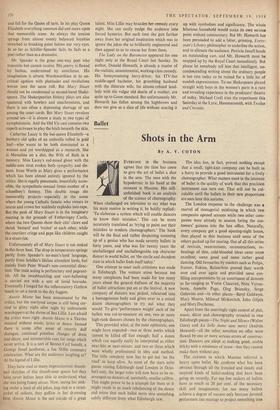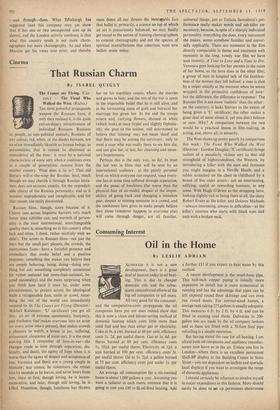B a lle t
Shots in the Arm
By A. V. COTON
EVERYONE in the business agrees that the time has come to give the art of ballet a shot in the arm. The man with the hypodermic in his hand at the moment is Massine. His still- unfinished book is an analysis of the science of choreography. When challenged on television to say what was his main motive in writing it, he boldly replied : 'To elaborate a system which will enable dancers to know their mistakes.' This can be more accurately translated as 'trying to point out their mistakes to modern choreographers.' The book will be .the final and rather despairing summing up of a genius who has made seventy ballets in forty years, and who was for twenty years the unchallenged and unchallengeable top character dancer in world ballet, on 'the sterile and decadent state in which ballet finds itself today.'
One attempt to meet such criticisms was made in Edinburgh. The venture arose because too many complaints had been made for too many years about the general dullness of the majority of ballet attractions put on at the festival. A new company of dancers was picked, rehearsed into a homogeneous body and given over to a mixed dozen choreographers to try out what they would. To give 'performance weight' each of the ballets was cut-to-measure on one, two or more high-rank dancers chosen by the choreographers.
This provided what, at the most optimistic, one might have expected—two or three works which cannot be killed off fast enough; half a dozen which can equally easily be interpreted as either near-hits or near-misses; and two or three which were wholly professional in idea and method. The little company now has to get out 'on the road' to keep alive. As most of the stars were guests visiting Edinburgh (and London in Octo- ber) only, the larger roles will now have to be re- arranged on dancers of, inevitably, smaller calibre. This might prove to be a triumph for them or it might result in so much rebalancing of the dance and mime that each ballet turns into something subtly different from what. Edinburgh saw. The idea has, in fact, proved nothing except that a small, tight-knit company can be built in a hurry to provide a good instrument for a lively choreographer. What matters most in the interests of ballet is the quality of work that this precision instrument can turn out. That will not be cal- culable until the ballets in their new proportions are seen later this autumn.
The London response to the challenge was a marvel of managerial mistiming in which two companies opened seasons while two other com- panies were already in session luring the cus- tomers' guineas into the box office. Naturally, every company got a good opening-night house, then played to thin business until some of the others packed up for touring. Out of all this series of revivals, resurrections, reconstructions, re- beatings of thin, cold-blooded ideas came some excellent, some good and some rather good dancing. Old favourites by masters such as Petipa, Ivanov, Fokine, Balanchine proved their worth over and over again and provided some eye- filling interpretations by an assortment of dancers as far-ranging as Yvette Chauvird, Nina Vyrou- bova, Annette Page, Oleg Briansky, Serge Golovine and—in other places—Beryl Goldwyn, Mary Munro, Milorad Miskovitch, John Gilpin and Mary Duchesne.
Apart from the unerringly right control of plot, music, decor and choreography revealed in two Edinburgh pieces—The Night and Silence (Walter Gore) and La belle dame sans merci (Andrea Howard)—all the other novelties on offer were flawed by one or more serious errors of construc- tion. Dancers are adept at making good, usable bricks with a minimum of straw—but they cannot make them without any.
The sickness to which Massine referred is heavy upon ballet. He confirms what has been obvious through all the frenzied and steady and inspired kinds of ballet-making that have been going on recently. Far too few makers of ballets have as much as 20 per cent. of the necessary skill and imagination; far too many ballets achieve a degree of success only because devoted performers can manage to project something into —and through—them. What Edinburgh has suggested (and this company may yet show that it has one or two unsuspected aces up its sleeve), and the London activity confirms, is that what this country needs is not more chore- ographers but more choreography. As and when Massine get his views into print, and thereby rams down all our throats the inescapable fact that ballet is, primarily, a science on top of which an art is precariously balanced, we may finally get round to the notion of training choreographers to commit choreography and not the species of spiritual masturbations that constitute most new ballets made today.



































 Previous page
Previous page